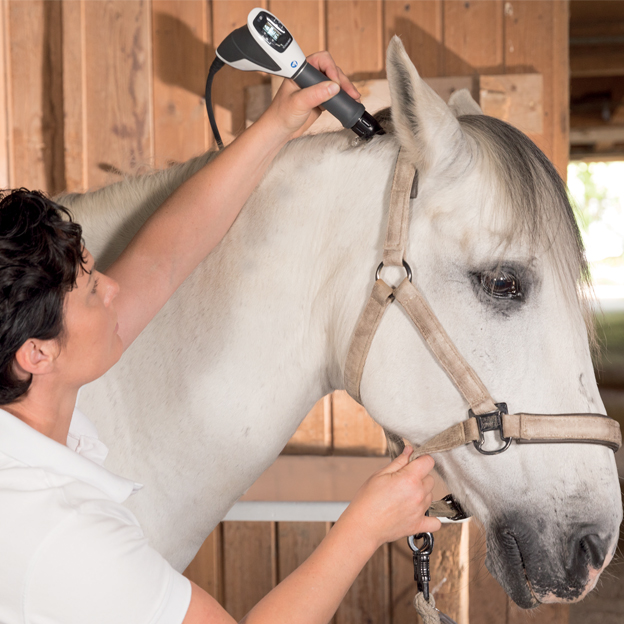Discover the Remarkable Advantages of Equine Therapy for Psychological Healing
Discover the Remarkable Advantages of Equine Therapy for Psychological Healing
Blog Article
How Laser Treatment in Equine Treatment Is Transforming Veterinary Treatment for Horses
Laser therapy has emerged as a transformative technique in equine veterinary care, supplying a non-invasive option that speeds up recovery and improves total health and wellness. Leveraging precise light wavelengths, this cutting-edge treatment stimulates mobile regrowth, minimizes inflammation, and reduces pain. Its effectiveness extends from bone and joint injuries to persistent disorders like osteoarthritis, considerably improving flexibility and life top quality for steeds. The mobility and flexibility of laser treatment gadgets further underscore their expanding indispensability among vets. As we check out the elaborate mechanics and real-world successes, the profound influence on equine clinical practices becomes increasingly noticeable.
Understanding Laser Treatment

The technology behind laser treatment is based in the principle of photochemistry, where photons are absorbed by chromophores within cells, resulting in boosted ATP production and inflection of reactive oxygen varieties (Equine Therapy). This, in turn, advertises cellular proliferation, decreases swelling, and increases recovery. Vet professionals make use of various sorts of lasers, consisting of low-level lasers (LLLT) and high-power Course IV lasers, depending on the specific healing objectives and the nature of the equine condition being treated
Different laser wavelengths and power settings are very carefully chosen to target various cells depths and achieve desired professional end results. Safety protocols are paramount, as incorrect use can bring about thermal damages or suboptimal therapeutic impacts. Therefore, an extensive understanding of laser therapy's systems and applications is critical for its efficient execution in equine veterinary method.
Advantages for Equine Health
The myriad advantages of laser therapy for equine health encompass boosted recovery, discomfort reduction, and boosted mobility. This sophisticated treatment modality leverages particular wavelengths of light to pass through cells, boosting cellular function and promoting rapid tissue repair. The non-invasive nature of laser therapy ensures marginal tension and discomfort for the steed, assisting in a smoother recovery process.
Boosted recovery is just one of the primary benefits, as laser treatment accelerates mobile regrowth and collagen synthesis. This leads to much faster healing times from injuries and medical treatments. Pain decrease is attained with the anti-inflammatory results of laser treatment, which decreases swelling and minimizes the production of pain-inducing chemicals. Consequently, steeds experience considerable relief from persistent and sharp pain problems.
By reducing swelling and pain, and improving tissue repair service, laser treatment helps in recovering joint function and muscle mass versatility. Thus, laser treatment stands as a transformative device in modern-day horse vet treatment.
Usual Conditions Dealt With
Laser therapy has arised as a flexible treatment option for a selection of common equine problems. In addition, laser therapy his comment is here is effective for problems like osteo arthritis, where it aids minimize joint swelling and promote cells repair.
Wound administration is one more area where laser therapy has actually revealed substantial assurance. Persistent injuries or slow-healing abscess can be especially challenging in equines, but laser therapy improves cellular regrowth and boosts blood circulation, thus expediting the recovery procedure. Furthermore, laser therapies have actually been efficiently employed in handling hoof problems such as laminitis and abscesses, reducing discomfort and promoting much faster recovery.

Innovation Behind Laser Treatment
Beyond the myriad conditions treatable with laser therapy, the modern technology itself values better exam. At the heart of laser treatment is the use of specific wavelengths of light to penetrate cells and generate biological responses. These wavelengths, generally ranging from 600 to 1000 nanometers, are uniquely absorbed by chromophores in the skin, muscular tissue, and other cells, prompting a cascade of mobile occasions.
Laser devices made use of in vet medicine usually make use of low-level laser treatment (LLLT) or cold laser therapy. Unlike high-powered surgical lasers, these gadgets run at reduced power levels, enhancing therapeutic advantages while minimizing thermal damages. The energy from the laser light stimulates adenosine triphosphate (ATP) manufacturing, improves cellular metabolic process, and accelerates tissue repair service procedures.

Success Stories and Case Research Studies

Showcasing the substantial benefits of laser therapy, countless success tales and instance studies brighten its transformative influence on equine health and wellness. One such case entails a pureblooded racehorse struggling with persistent tendonitis. Traditional therapies yielded very little enhancement, yet after integrating laser look at more info treatment right into the program, the horse exhibited considerable reductions in swelling and pain within weeks, eventually going back to affordable racing.
An additional compelling example features a dressage steed detected with severe neck and back pain, restricting its efficiency. A vet group used low-level laser treatment (LLLT) to target the irritated locations, resulting in marked improvement in adaptability and a remarkable reduction in pain. Over several sessions, the horse regained its peak kind, showcasing the efficiency of laser therapy in dealing with bone and joint issues.
Additionally, a research conducted at a leading equine facility taken a look at 50 steeds with numerous soft tissue injuries treated with laser therapy. The results stood out: 85% of the equines demonstrated accelerated healing times and boosted flexibility. These situations highlight the adaptability and efficiency of laser therapy in equine medication, using a non-invasive, scientifically-backed method to enhancing healing and efficiency in horses.
Conclusion
Laser treatment is changing equine vet care by offering a non-invasive treatment that increases healing, decreases swelling, and eases pain. With its effectiveness in treating a variety of problems, from bone and joint injuries to persistent conditions like osteo arthritis, this innovation considerably boosts equine health and wellness and flexibility. The mobility and versatility of laser treatment better emphasize its transformative impact on vet techniques, solidifying its function as an important tool in contemporary equine medical care.
Report this page